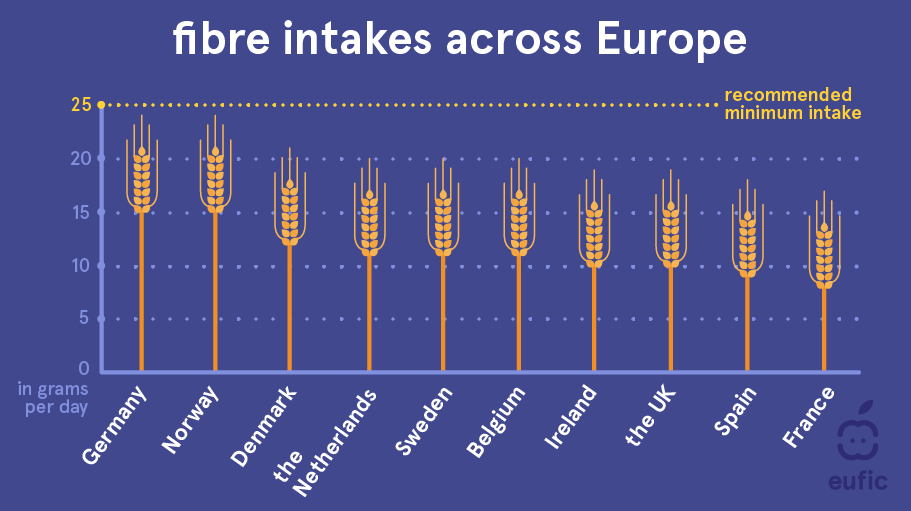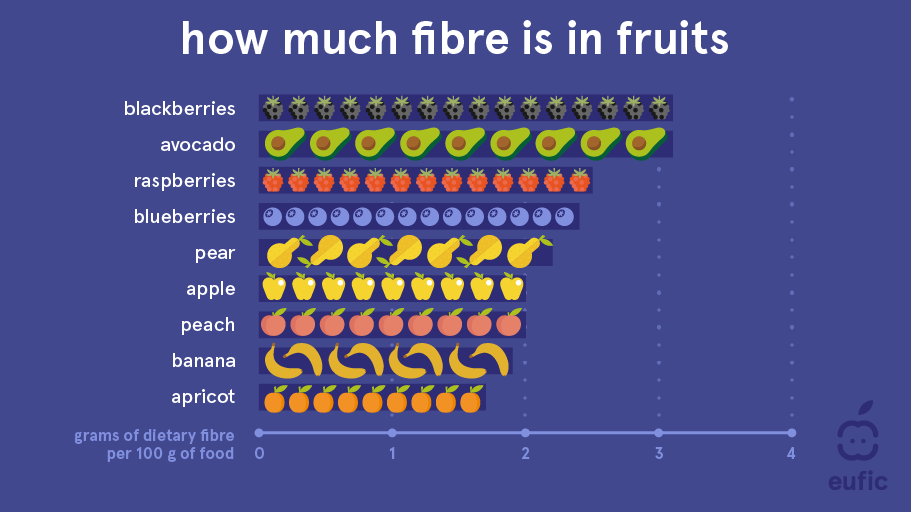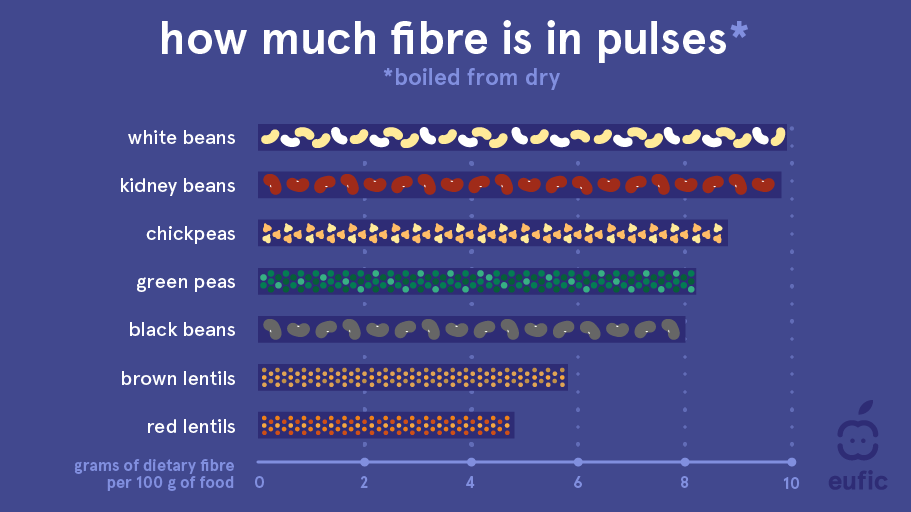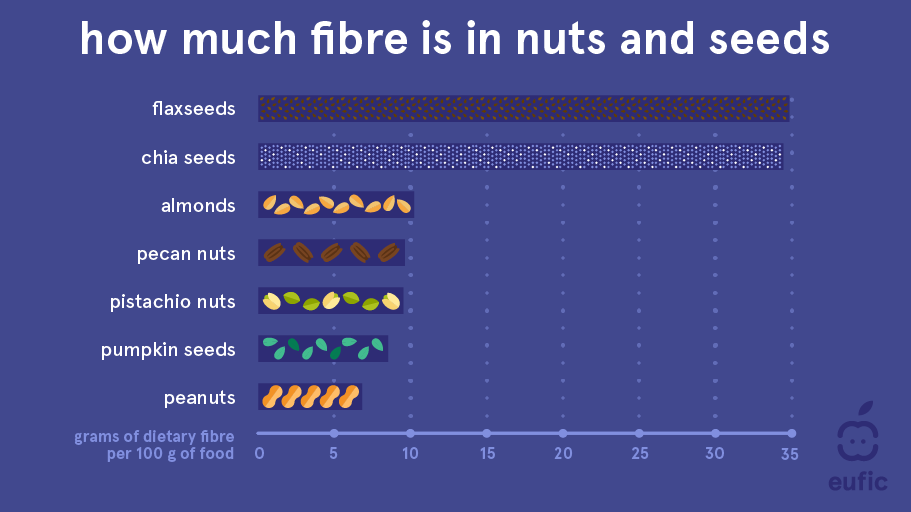Recommended daily intake of fibre and fibre-rich foods to help you achieve it
Last Updated : 26 October 2023Fibre plays an essential role in maintaining our overall health and well-being. Yet, most of us do not eat the recommended amount. Which fibre-rich foods can we incorporate in our diet to help us get closer to our daily fibre target? And are fibre supplements beneficial to help us increase our fibre intake? This article explores the recommended daily intake of fibre and the diverse range of fibre-rich foods to help us achieve it.
What’s the recommended daily fibre intake?
The European Food Safety Authority (EFSA) has set a recommended daily intake on dietary fibre. Based on the available evidence on bowel function and for the prevention of non-communicable diseases such as type 2 diabetes, colorectal cancer, cardiovascular diseases and overweight and obesity, they recommend a daily intake of (at least) 25 g of dietary fibre for adults. In children from the age of one year, the recommended amount varies according to the energy requirements of different age groups (about 2 g of dietary fibre per 240 kcal).1
Most European dietary guidelines recommend a daily intake of dietary fibre of 25-35 g for adults (30-35 g of fibre per day for men and 25-32 g per day for women).2
How much fibre do we eat in Europe?
Daily dietary fibre intakes differ significantly across European countries and between population categories. However, most European (adult) citizens fall short of the recommended 25 g per day. On average, intakes for adult males in Europe range from 18-24 g per day and for females 16-20 g per day, with little variation from one European country to another.2

What are examples of fibre-rich foods?
Dietary fibre is found in fruits, vegetables, roots and tubers, pulses, nuts and seeds, and cereals. Dietary fibre is often categorized according to its solubility into soluble or insoluble. Soluble fibre dissolves in water and forms a gel-like substance, aiding in digestion and regulating blood sugar levels. Insoluble fibre adds bulk to stool and helps prevent constipation. Both types of fibre are found in different proportions in fibre-containing foods. Good sources of soluble fibre are oats, barley, fruit, vegetables, and pulses (beans, lentils, chickpeas) while whole grain cereals and whole grain bread are rich sources of insoluble fibre.
Getting your fibre from various sources is important as various fibre-rich foods come with different vitamins, minerals, and other nutrients. Furthermore, having a mix of soluble and insoluble fibre promotes good digestion.
Below we show you a few examples of how much fibre you can get from 100 grams of various foods.3 In the EU, whole grain cereals, pulses, fruit, vegetables, and potatoes are the main sources of dietary fibre.4
|
|
Dietary fibre, per 100 g |
|
Fruits |
|
|
Blackberries |
3.1 |
|
Avocado |
3.1 |
|
Raspberries |
2.5 |
|
Blueberries |
2.4 |
|
Pear |
2.2 |
|
Apple |
2 |
|
Peach |
2 |
|
Banana |
1.9 |
|
Abricot |
1.7 |
|
Vegetables & potatoes |
|
|
Celeriac |
4.9 |
|
Kale |
4.7 |
|
Brussels sprouts |
4.5 |
|
Green cabbage |
4.1 |
|
Broccoli |
3.1 |
|
Carrot |
2.9 |
|
Beetroot |
2.9 |
|
Potatoes |
1.8 |
|
Pulses* |
|
|
* boiled from dry |
|
|
White beans |
9.9 |
|
Kidney beans |
9.8 |
|
Chickpeas |
8.8 |
|
Green peas |
8.2 |
|
Black beans |
8 |
|
Brown lentils |
5.8 |
|
Red lentils |
4.8 |
|
Cereals |
|
|
Rye bread |
8.2 |
|
Oatmeal |
7.3 |
|
Quinoa (uncooked) |
7 |
|
Whole grain pasta (uncooked) |
6.9 |
|
Whole wheat bread |
6.7 |
|
Brown rice (uncooked) |
3 |
|
White (refined) pasta (uncooked) |
3 |
|
White bread |
2.5 |
|
Nuts and seeds |
|
|
Flaxseeds |
34.8 |
|
Chia seeds |
34.4 |
|
Almonds |
10.2 |
|
Pecan nuts |
9.6 |
|
Pistachio nuts |
9.5 |
|
Pumpkin seeds |
8.5 |
|
Peanuts |
6.8 |
Fruits & vegetables
Fruits and vegetables are some of the most abundant sources of dietary fibre. Apples, pears, berries, oranges, broccoli, carrots, and spinach are just a few examples of fibre-packed options. Incorporating a colourful array of fruits and vegetables into your meals (or as snacks) ensures a diverse intake of essential nutrients and fibre.


Cereals
All whole grains are fibre-rich choices. These include, for example, oats, brown rice, quinoa, and whole wheat products. These grains can be used in a wide range of dishes, from porridge to salads, to boost your daily fibre intake.

Pulses
Bean, lentils, chickpeas, and peas are part of the legume family and are known for their high fibre content. They are not only versatile ingredients in soups, stews, and curries but also provide a hearty dose of plant-based protein along with their fibre.

Nuts and seeds
Almonds, chia seeds, flaxseeds, and walnuts are some examples of nuts and seeds that contain significant amounts of fibre. They make for convenient and nutritious snacks or can be sprinkled on yoghurt, oatmeal, or salads to up your fibre intake.

Animal-based foods
Animal-based foods like meat, poultry, fish, seafood, dairy, and eggs do not contribute fibre to your diet. Dietary fibre is exclusively found in plants.
Are fibre supplements beneficial?
Fibre supplements are typically an isolated fibre source and do not provide many of the health benefits associated with fibre from whole plant foods.5,6 Whole plant foods do not only contain fibre but also a variety of other important nutrients, such as vitamins, minerals, antioxidants, and phytochemicals that may work in synergy with fibre to improve health. Isolated fibre supplements also often focus on one type of fibre and may lack the complexity and diversity of fibres found in whole foods that lead to health benefits. Dietary patterns high in fibre also tend to be lower in calories, salt, added sugars and saturated fat which we know are risk factors for non-communicable diseases. It is also important to remember that much of the research linking fibre to its health benefits (e.g., reduced mortality from cardiovascular disease, stroke, type 2 diabetes, and colon cancer) relates to eating fibre-rich foods as opposed to synthetic and extracted fibre sources. In other words, the health benefits of fibre may not translate to fibre taken in supplemental form.7 Unless under medical advice, stick to a food-first approach and opt for fibre from a large variety of different plant sources.
Nonetheless, fibre supplements may be beneficial in certain circumstances and have demonstrated specific health benefits in various clinical trials. These effects are dependent on the type of fibre supplement consumed and may include lowering LDL-cholesterol and improving glycaemic control (beta-glucan, psyllium, guar gum) and improving regularity/constipation (wheat bran, psyllium).6
Summary
Achieving the recommended daily intake of fibre is essential for maintaining optimal health and preventing non-communicable diseases. The EFSA recommends (at least) 25 grams of dietary fibre for adults per day. Most European citizens fall short of this recommendation. However, with a few simple tweaks like adding more fruits and vegetables, whole grains, legumes, nuts and seeds you will be on track to meet your daily recommendation.
Are you finding it hard to come up with meal ideas to hit your fibre target? Take a look at this example to see how you can easily hit your recommended daily fibre intake.

References
- Agostoni, C. V., Bresson, J. L., Fairweather Tait, S., Flynn, A., Golly, I., Korhonen, H., ... & Verhagen, H. (2010). Scientific opinion on dietary reference values for carbohydrates and dietary fibre. EFSA journal, 8(3).
- Stephen, A. M., Champ, M. M. J., Cloran, S. J., Fleith, M., Van Lieshout, L., Mejborn, H., & Burley, V. J. (2017). Dietary fibre in Europe: current state of knowledge on definitions, sources, recommendations, intakes and relationships to health. Nutriti
- Dutch Food Composition Database (NEVO). NEVO-online version 2021/7.1. Retrieved from https://nevo-online.rivm.nl/Home/en
- European Commission. (2021). Dietary fibre. Retrieved from https://knowledge4policy.ec.europa.eu/health-promotion-knowledge-gateway/dietary-fibre_en (Accessed 02/10/2021)
- Lambeau, K. V., & McRorie Jr, J. W. (2017). Fiber supplements and clinically proven health benefits: How to recognize and recommend an effective fiber therapy. Journal of the American Association of Nurse Practitioners, 29(4), 216-223.
- White, N. (2020). A Guide to Recommending Fiber Supplements for Self-Care. American Journal of Lifestyle Medicine, 14(6), 589-591.
- Reynolds, A., Mann, J., Cummings, J., Winter, N., Mete, E., & Te Morenga, L. (2019). Carbohydrate quality and human health: a series of systematic reviews and meta-analyses. The Lancet, 393(10170), 434-445.


